Don't wanna be here? Send us removal request.
Text
Pre-examination System——One Way to Expedite Prosecution of Invention Patents in China
Besides patent prosecution highway (PPH) and prioritized examination, pre-examination system is also one way to expedite prosecution of invention patents in China.
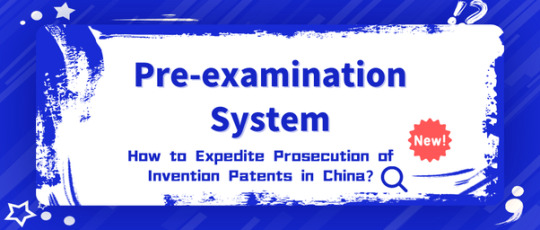
From 2016, many intellectual property protection centers have been successively set up throughout China. These IP protection centers perform patent pre-examination services for patent applications. Applications that pass pre-examination can quickly enter the examination channel before the CNIPA.
How fast?
According to an official news release, the time to grant a patent application submitted to CNIPA after passing pre-examination can be shortened. It is about 3 months for invention patents; about one month for utility model patents; and less than 10 days for design patents.
What are the requirements for requesting pre-examination?
In order to apply for pre-examination before an IP protection center in China, an application must satisfy the following four conditions:
a) The applicant should submit the pre-examination application to the proper IP protection center prior to formally submitting the patent application to CNIPA;
b) The registered address of the applicant must be in a location where an IP protection center is located;
c) The applicant has been recorded before the IP protection center; and
d) The application submitted must be within the technical field of the IP protection center.
It should be noted that different IP protection centers in China provide pre-examination services in different technical fields. Therefore, the applicant should check whether their inventions are within the technical field of a specific IP protection center.
Can foreign applicants request for pre-examination?
It should be noted that the pre-examination system is not applicable for Chinese national phase entry application of a PCT international application.
In addition, the registered address of the applicant (enterprise, university, or research institute) must be in a location where an IP protection center is located, and the application submitted must be within the technical field of the IP protection center.
Therefore, if a foreign applicant wants to file a request for pre-examination, the applicant should have an entity registered in China.
Different IP protection centers provide patent pre-examination services in different technical fields.
The Beijing Center mainly focuses on the fields of generating new information technology and high-end equipment manufacturing.
The Shanghai Pudong Center focuses mainly on the fields of biomedical and high-end equipment manufacturing.
The Guangdong Center focuses mainly on the fields of new generation of information technology and biological industry.
So, if a foreign applicant wants to register a company in China to be qualified for pre-examination, he/she should choose a place where 1) a protection center is located; 2) the technical filed of the protection center is close to the technical field of the company.
4 notes
·
View notes
Text
Prioritized Examination——One Way to Expedite Prosecution of Invention Patents in China
Besides patent prosecution highway (PPH), prioritized examination is also one way to expedite prosecution of invention patents in China

Similar to certain acceleration provisions before the USPTO, in some situations it is possible to expedite prosecution of a Chinese patent application based on real-world developments. For example, if a particular invention is directed to certain technologies, or is actively being infringed, or is of particular national or public interest, that patent application can be examined on a fast track.
How fast?
For invention patents, if the Request for Prioritized Patent Examination is accepted, the Chinese Patent Office will examine and issue a first Office Action within 45 days, with examination being completed within one year of the request.
When can you file the Prioritized Examination Request?
For invention application, you may file a request for Prioritized Examination after the application has entered the stage of substantive examination, before or after the first Office Action is issued.
What are the requirements for Prioritized Examination?
Patent applications are entitled to Prioritized Examination, if:
1) They involve national key development industries such as energy conservation and environmental protection, new generation information technology, biology, high-end equipment manufacturing, new energy, new materials, new energy vehicles, and smart manufacturing;
2) They involve industries encouraged by the provincial and district-level municipal governments;
3) They involve the Internet, big data, cloud computing and other fields and the technology or product obsolescence is fast;
4) The patent applicant has made preparations for implementation or has began implementation, or there is evidence that others are implementing their inventions;
5) The patent application was first filed in China and then filed in a foreign country; or
6) They are of great significance to national interests or public interests need to be reviewed first
The requirements are applicable for all patent applications in China. However, the results may be affected by some local policies and the situation undergoes constant change. Therefore, it is suggested to consult local counsel when it comes to decide whether and how to apply for prioritized examination.
What are the documents needed for Prioritized Examination Request?
1) Priority exam request;
2) Prior art;
3) Proof of meeting the requirements; and
4) Power of attorney
Please note that for invention applications under Prioritized Examination, the Office Action should be responded within 2 months. Besides, the applicant is not entitled to a 15-day grace period on postal delivery which it is otherwise entitled for normal examination. Further, the applicant is not entitled to extensions if the applicant wants to maintain prioritized examination.
1 note
·
View note
Text
Use PPH to Expedite Prosecution of Invention Patents in China
The examination prosecution of invention patents in China generally takes two years. Patent Prosecution Highway (PPH) is one way to expedite prosecution.

What is Patent Prosecution Highway (PPH)?
PPH is a framework in which an application whose claims have been determined to be patentable in the Office of First Filing (OFF) is eligible to go through an accelerated examination in the Office of Second Filing (OSF) with a simple procedure upon applicant’s request.
China is party to PPH agreements with many countries including the United States. Simply put, if you file a US application first, and receive a Notice of Allowance or an Office Action indicating one or more allowable claim(s), you may use it to expedite the examination procedure of its counterpart Chinese application.
How fast?
If a request for PPH is granted, you may receive the first Office Action within 2 months, several months earlier than ordinary applications.
When can you file the PPH request?
The application has entered the phase of substantive examination, but the CNIPA has not issue Office Actions. It is recommended that you file PPH request when file Request for Substantive Examination.
What are the requirements for PPH?
1) The Chinese application have a counterpart application in other participating countries.
2) At least one claim in the corresponding application indicated to be patentable.
3) Claims in the Chinese application must sufficiently correspond to an allowed claim in the corresponding application.
Both Paris-PPH and PCT-PPH are applicable for Chinese patent applications. That is to say, either you file a US application and receive favorable results, or you file a PCT application in the US and receive positive examination reports, in both cases, you can file a PPH request for its corresponding Chinese application.
What are the documents needed for PPH request?
1) PPH request form;
2) Office actions from OFF and the translations;
3) Allowable claims and the translations;
4) Prior art from the priority application;
5) A table showing correspondence between the pending Chinese claims and the allowed claims of the priority application.
The materials can be prepared by your Chinese counsel. Just follow their instructions.
1 note
·
View note
Text
Patent Examination Procedures in China
Generally speaking, prosecution procedures of Chinese patent applications, expecially for inventions, include five steps: acceptance, preliminary examination, publication, substantive examination and grant.
However, examination procedures of CN utility model or design patent application do not include publication and substantive examination
The picture below outlines examination procedures of CN invention patent applications.

Step 1 Acceptance of Patent Filing
The application can be hand-delivered or mailed to the office of China National Intellectual Property Administration (CNIPA) in Beijing or you can file it via the CNIPA’s representative offices located in provincial intellectual property offices. The easiest way, however, is to submit the application online on the website of CNIPA.
Step 2 Preliminary Examination
The Preliminary examination of a patent application for invention is an indispensable procedure after receipt of the application and before its publication.
During preliminary examination, for a patent application whose application documents have defects that can be eliminated through rectifications OR obvious substantive defects that cannot be eliminated through rectifications, the applicant will receive the Notification to Make Rectification OR an Office Action, in which the defects existing in the patent applicant will be pointed out and the time limit for response will be specified.
If a patent application has passed the preliminary examination, the applicant will receive the Notification of Passing Preliminary Examination and the application will enter into the publication procedure.
Step 3 Publication
If a patent application is successfully preliminary examined, it will be published in the Invention Patent Gazette within 18 months from the application filing date. However, upon the request of the applicant, CNIPA may publish the application earlier.
Step 4 Substantive Examination
After the Chinese patent application is successfully preliminary examined, it will enter into substantive examination as long as the applicant has filed a request for substantive examination.
The request for substantive examination must be filed within three years from the filing date or, if priority is claimed, from the earliest priority date, and the substantive examination fee must be paid in full within the time limit.
Otherwise, the application shall be deemed to have been withdrawn. CNIPA will not start the substantive examination for the application until it is specifically requested to do so.
The purpose of substantive examination is to judge whether the patent right shall be granted to an invention application, especially whether the application meets the requirement of novelty, inventive step and practical applicability.
If your application does not meet the requirements of novelty, inventive step and practical applicability, you will receive the First Office Action. If your response does not overcome problems in the First OA, you will receive the second or third Office Action.
However, if it is found that there are no grounds for rejection of the invention application, CNIPA will make a decision to grant the patent right for invention.
Step 5 Grant and Announcement
Once CNIPA issues a Notification to Go Through Formalities of Registration (Notification), this application has been allowed for grant. After receiving the registration fee, CNIPA will issue a certificate of the patent and publish the patent. The patent shall take effect from the publication date.
The official registration fee, which includes annuity fee and a patent printing fee, must be paid within the time limit specified in the notification. If you fails to pay the fee, your patent will be considered as “abandoned”.
0 notes
Text
Some Notes for the Official Fees Chinese Patent Applications
1).The basic filing fee, priority claim fee (if applicable), publication fee (applicable for patent applications), additional fees (including excess claim fee and application size fee) are required to be paid to the Chinese National Intellectual Property Administration (CNIPA) along or after the application filing.
2).For direct filing or applications entered by Paris Convention route, the fees can be paid within two months after the filing of application, or within 15 days after receipt of the filing receipt.
3).For applications entered by PCT route, the fees can be paid after the filing or within 30-month deadline. However, the national entry date shown on the filing receipt will be the later of Chinese application filing date or the payment date.
4).Besides, for PCT applications which are not filed or searched by the CNIPA, some national stage fees may be waived. Specifically,
for PCT applications filed with the CNIPA, some basic fees, e.g., basic filing fee, excess filing fee and 50% of the fee for requesting substantive examination will be waived during the Chinese national stage.
for PCT applications searched by the CNIPA, 50% of the fee for requesting substantive examination will be waived during the Chinese national stage.
or PCT applications searched by the European Patent Office, Japan Patent Office and Swedish Patent and Registration Office, 20% of the fee for requesting substantive examination will be waived during the Chinese national stage.
5).All fees can be paid in advance of each stage. And since the process of the payment are quite complex for applicant outside China, it is suggested that the applicant appoint an agent or an agent firm to represent the filing of the application.
6).After the registration process is finished, the annuity fees need to be paid to the CNIPA each year to maintain the patent in force.
7).For applicants located in Mainland China, it may enjoy an official fee reduction policy if it complies with the rules prescribed by the CNIPA. But for applicants located outside of China, it is hard to comply with the requirements for fee reduction.
0 notes
Text
How much does it cost to file a design patent in China?

Compared with utility model patents, there is not much difference in official fees for design patents in China.
Filing Fees for Design Patents

Miscellaneous Fees for Design Patents
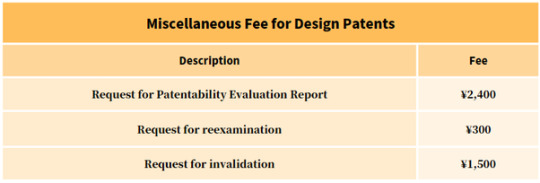
Annuities for Design Patents

0 notes
Text
How much does it cost to file a utility model patent in China?
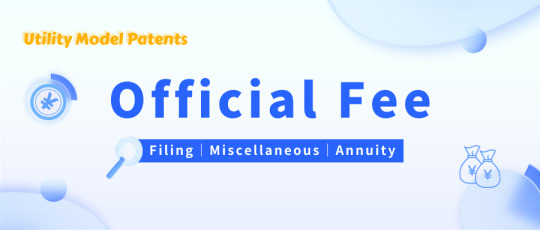
Compared with invention patents, it is much cheaper to file a utility model in China.
Filing Fees for Utility Model Patents
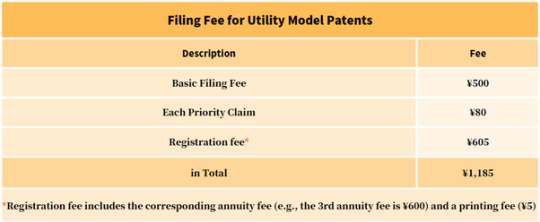
Miscellaneous Fees for Utility Model Patents
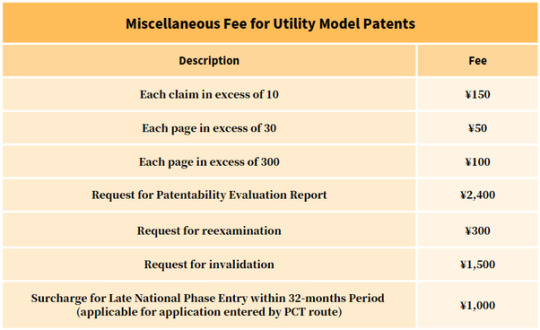
Annuities for Utility Model Patents
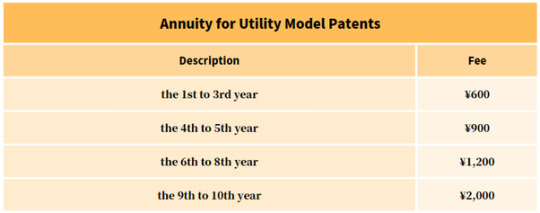
0 notes
Text
How much does it cost to file an invention patent in China?

The official fees currently applicable for Chinese patent applications takes effect on November 22, 2019. This article briefly introduces basic official fees of a regular invention patent application and some miscellaneous fees under specific circumstances.
Filing Fees

Miscellaneous fees

Unlike US patent applications whose basic filing fee covers 100-page application document, the basic filing fee of Chinese patent applications covers 30-page application document. In addition, the independent claims over 3 and multiple dependent claims are free of charge in Chinese patent applications. Only the claims in excess of 10 will be charged separately.
Annuities for Invention Patents

0 notes
Text
What other documents should be submitted for Chinese applications (Inventions, Utility Model or Design)?
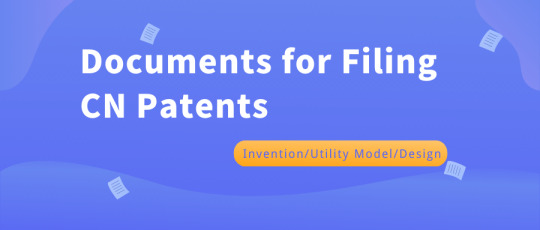
In addition to documents mentioned in the previous article, there are other documents that that should be filed with the CNIPA.
Power of Attorney (POA)
If a foreign applicant, enterprise or organization does not have a residential or business address in China, he must appoint a legally established patent agent to represent them in the patent prosecution procedure before the CNIPA. To set up such a representative relationship, the applicant should execute/seal on a power of attorney prepared by the agent or agent firm. Neither notarization nor legalization need to be furnished with on the POA. For more details about the POA, you can visit https://www.cnipa.gov.cn/transfer/bgxz/zlsqbg/ty/100021zldlwts.doc.
DAS code or Certified Priority Document
The DAS code or an electronic copy of certified priority document shall be submitted within three months from the filing date of Chinese application, without incurring any charge officially. If it is not submitted in due course, it may be confronted with a danger that the priority is not claimed successfully.
Assignment
If the applicant of the Chinese patent application differs from that recorded in the priority application, an assignment shall be filed with the CNIPA within 16 months from the earliest priority date. It should indicate that the right to file a Chinese application claiming to the priority application is assigned from the applicant as filed in the priority application to the current applicant of the to-be-filed Chinese patent application.
Due to the complexity of the Chinese patent practices, it is advisable for the applicant to appoint a qualified Chinese agent to help prepare the application document in Chinese and make appropriate amendments.
0 notes
Text
What information should a Request for filing Chinese patent applications include?

Regardless of the type of patent in China, a Request for filing Chinese invention/utility model/design application is required. What information should the Request include?
The information required in a Requests for filing these three types of Chinese patent applications are basically the same:
The name, address and nationality of the applicant;
The name and address of the inventor. If the first inventor is a Mainland Chinese, he is required to provide his identity card number (ID card No.). His name in Chinese should also be consistent with that shown on his ID card.
Priority claim: if a previous application filed in other country/region, it can be claimed as a priority of the Chinese patent application. The filing date thereof, the country/region accepting the application and the priority application number should be indicated in the filing request.
Please kindly note that, all the information should be provided in Chinese. If no corresponding Chinese can be provided by the applicant, the agent will translate it/them into appropriate Chinese and fill in them in the Request.
Some special requests for Chinese applications
Request for Substantive Examination (for invention applications)
A request for substantive examination may be filed upon filing, and no later than 3 years from the earliest priority date.
To expedite prosecution, the agent usually suggests that a request for substantive examination be filed upon filing. However, a delayed request for substantive examination may delay costs and allow more time for the applicant for commercial and/or technological development based on the invention.
Request for Deferred Examination (for invention and design applications)
As the request for deferred examination is usually filed in the Chinese invention applications, we would mainly introduce the deferred examination in the invention application.
A request for deferred examination for invention application shall be filed concurrently with the filing of the request for substantive examination by the applicant, and the request for deferred examination shall take effect from the date when the request for substantive examination takes effect.
The deferral period shall be one, two or three years from the date of entry into force of the request for deferred examination. Upon expiration of the deferral period, the application shall be examined in accordance with the sequence.
When necessary, the CNIPA can initiate its examination procedure and inform the applicant that his or her request for deferred examination is terminated.
Request for Early Publication (for invention applications)
A Chinese application usually publishes approximately 18 months from its earliest priority date. However, if a request for early publication is filed, a Chinese application publishes after completion of the formality examination which takes approximately 3-6 months after filing.
#patent in china#patent services#request for filing Chinese patents#Early Publication#Deferred Examination#Substantive Examination
0 notes
Text
What necessary documents should be submitted for Chinese applications (Inventions, Utility Model or Design)?

According to the Chinese Patent Law, there are three types of patent applications which can be filed with the China National Intellectual Property Administration (CNIPA), namely invention applications, utility model applications, and design applications.
What documents should the applicant submit for invention applications?
Request for filing Chinese invention application
Claims
Specification, including technical disclosure, background information, the content of invention, description of the figures, and specific embodiments.
Figures
Abstract
Figure accompanying the Abstract (for national applications entered by PCT route)
What documents should the applicant submit for utility model applications?
Request for filing Chinese utility model application
Claims
Specification, including technical disclosure, background information, the content of invention, description of the figures, and specific embodiments.
Figures
Abstract
Figure accompanying the Abstract (for national applications entered by PCT route)
What documents should the applicant submit for design applications?
Request for filing Chinese design application
Claim (One claim)
Specification, describing the tile, the use, the major design point, and designating a figure which can show the major deign point clearly.
Figures, including front view, rear view, left-side view, right-side view, top view, bottom view and perspective view.
If the first filing is not filed with the CNIPA, the applicant can directly provide the technical documents of the first filing to the agent of the Chinese patent application, wherein the technical contents of the applications are basically the same. The Chinese agent will help translate the filing documents into Chinese and file a Chinese patent application with the CNIPA in due course.
0 notes
Text
How to request for foreign-filing License (FFL)?

According to Rule 8 of the Implementing Regulations of the Chinese Patent Law, an applicant could choose to request for a FFL in four ways:
File a separate request for a FFL with CNIPA, without or before filing a patent application in China;
File a request for a FFL at the time of filing a Chinese patent application;
File a request for a FFL after filing a Chinese patent application;
Filing a PCT application with CNIPA as the receiving office.
Detailed information is listed below:

The second method is recommended if you need to receive the license as soon as possible. You may file a Chinese application without requesting for early publication. Then you may choose to keep the application or withdraw it.
Frequently asked questions
1) What if an invention is changed after I get the foreign-filing license?
If an invention is changed after the foreign-filing license is granted, for example due to modifications, and such modifications amount to something to be claimed as a separate invention, then a separate request for a new foreign-filing license is needed.
2) What if an invention is developed corporately by a Chinese team and a US team? That is to say the invention is developed in two countries, and I want to file both a Chinese application and a US application. How shall I proceed?
Typically, the USPTO issues a foreign-filing license more quickly than the CNIPA. The USPTO can usually issue a foreign-filing license within a week under request for expedition, while the CNIPA vary from two weeks to three months. Therefore, for an earlier filing date, an advisable solution is to apply for the U.S. foreign filing license first, possibly in the expedited option, and then file the first patent application in China.
0 notes
Text
What Is FFL (Foreign-Filing Licenses)?

Companies involving cooperation with each other across the border should be aware that compliance with the FFL requirements is important – it will potentially affect the validity of a corresponding Chinese patent.
In what kind of situation should I request for a foreign-filing license (FFL) in China?
If the invention or utility model is developed in China, requirement must be complied with before filing a patent application outside China, including a US provisional application.
Two important points should be highlighted here:
It is an invention patent and a utility model patent;
This invention or utility model patent is developed in China.
The requirement is invoked when an invention is “developed in China”, and the nationality or residence of the inventors is not relevant. That is, a FFL is still required in China even for a US inventor who has “developed” an invention within China. On the other hand, if the invention was developed by a Chinese inventor while working in the US, then a FFL from China should not be necessary.
What constitutes “developed in China”?
Rule 8 of the Implementing Regulations of the Patent Law provides some guidance. Specifically, according to this rule, an invention or utility model is considered to be “developed in China” if the “substantive contents” of the technical solution of the invention or utility model have been made or created by an inventor within China. The “substantive contents” of the technical solution can be determined based on the contents of the claims and identification of the inventors.
What are the consequences if I violate the rule?
The penalty for violating this provision is that no patent shall be granted in China for that invention or utility model.
Violation of this provision is a ground for both rejection during the preliminary or substantive examination procedures and invalidation during the post-grant invalidation procedure. In addition, administrative sanctions or criminal charges may apply if an applicant violates the foreign filing license requirement as prescribed in Article 20 and divulges national secrets by applying for a patent in a foreign country.
0 notes
Text
Something About CN Patent Applications

This article will explain import time limit of filing CN application under the PCT and the Paris Convention. Also, three important points will be highlighted: foreign-filing license, appointment of pant agency/agent, and applicable language.
Important Time limit
For CN applications filed under the PCT, the application must be submitted to the patent office in China no later than 30 months from the priority date. When the applicant exceeds the 30-month time limit, the right of priority will still be restored if the priority period is within the 32 months from the priority date. Besides, the applicant needs to state the reason for the failure to file the application within the priority period, preferably accompanied by any declaration or other evidence required.
As for CN applications filed under the Paris Convention, there is no grace period to restore the right of priority.
Foreign-Filing License
When an invention or utility model is developed in China, the applicant must request for a foreign-filing license in China before filing a patent application outside China. Similar to it, if an invention or utility model is developed in foreign countries, for example, in the USA, the applicant needs to file a request for foreign-filing license in the USA. As for specific requirements of foreign-filing license, they vary from country to country.
Appointment of Patent Agency/Agent
Pursuant to Article 19 of the Chinese Patent Law, any foreigner, foreign enterprise or other foreign organization having no habitual residence or business office in China applies for a patent, or has other patent matters to attend to, in China, it or he shall appoint a legally incorporated patent agency to act as its or his agent.
Applicable Language
Except for certificates or evidence materials provided by foreign government departments or created in foreign countries, the patent application documents and other documents shall be in Chinese. Application documents which are written in foreign language shall be translated into Chinese.
The Chinese text of the patent application submitted by the applicant shall be taken as the basis of examination. The foreign language text of the application submitted by the applicant at the time of filling the application shall have no legal effect.
0 notes
Text
Three Ways to File Patents in China
Similar to apply for patents in US, there are also THREE ways in which a patent may be filed under the Chinese legal framework.

Direct Filing
A patent may be filed directly in China with the help of a patent agency or patent attorney;
Under the Patent Cooperation Treaty
An international patent application can be filed under the PCT, indicating China as one of the designated states. So, the application must be submitted to the patent office in China no later than 30 months from the priority date;
Under the Paris Convention
Filing a patent in a foreign country/region first and then filing a second application in China within 12 months for invention and utility model patents and 6 months for design patents. Thus, you’ll be able to claim the priority date of the first application. The foreign country/region must be a Member State of the Paris Convention.
1 note
·
View note